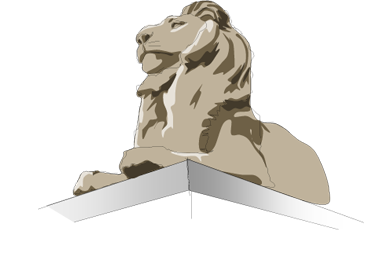
Sculpture is a physical or digital dimensional work of art, or the art of making it. Works may be carved, modeled, constructed, cast or projected. Sculpture may be an object set in place, a media event, or an entire environment. Sculptures can be described as assemblage, in the round and relief. Sculptures are made in a huge variety of media. In looking at sculpture, we see and perceive the whole environment with new eyes and a new consciousness. The tradition of sculpture includes every possible material, at every possible scale, for the expression of ideas in space—from wood and stone to light and sound, from the microscopic to the monumental, private to public, real to virtual. Sculptures can be static or kinetic, built to withstand time or to only last a short time. Sculptural expressions make us think about something in the world in a new way.
Start thinking and making!
Activity 1 – Personal Totem

Imagine a sentence that describes you. Think about all the creatures and forces and imaginations on earth. What animal best describes you? What force of nature? What mythical reference best captures your essence? Think about your understandings about your strengths of personality, as you see it, and as others see it. Maybe you have a secret side.
Native Americans carved poles. Using a paper towel cardboard tube or wrapping paper tube or large cylindrical can, cut paper and found materials to create your own totem pole. Write a sentence about the characteristics that the animals, force of nature and metaphors have that contribute to describing who you are.
Who are you?
Activity 2 – 3D Gargoyle Mask

Take a walk around your city or look at this website about gargoyles. Animals have been part of architectural ornament since the drawings of the cavemen. In cities you can find a wide assortment of birds, bears, lions, and even tigers. Many zoo buildings have animal sculptures. Animals as noble beings evoke characteristics that people admire - swiftness of foot, ability to fly, keenness of eyesight. What animal are you? First take stiff paper and create a cylinder that will fit around your head. Cut openings for your eyes and nose and mouth. Add the features of your gargoyle using tape, staples, and glue.
Activity 3 – Relief Home Sculpture

Go on a mission and collect materials. Find things around your house and start accumulating them. For example, can tab tops, milk gallon plastic rings, cardboard cereal boxes, newspapers, safety pins, marbles, bread bag clips, string, etc. Look for things that are accumulated quickly over the period of a week. Clothes dryer lint makes a wonderful material that comes in beautiful colors. Take a stiff board or piece of cardboard. Compose and glue your found material in a relief or raised pattern on the board. Create something out of nothing!
Activity 4 – Nature's Sculpture
Stick and stones can be sculpted! Look around your yard or neighborhood for nature’s kit of parts. Start a collection. You will probably need bags or boxes to collect things that you find. You can start as simply as picking up sticks and stones. You can choreograph fallen leaves. You can make a pattern with rocks. Once you start looking at the beauty of nature’s parts, start thinking about what you would like to make. Look at the work of Andy Goldsworthy, Patrick Dougherty and Robert Smithson. See how they started small and then created large works of art. The large scale sculptures are called environmental art because they exist in the environment. Find a corner of your yard or a spot on the sidewalk. Arrange nature’s artifacts as art. Compose. Consider. Recompose. Reconsider. Let your ideas grow.
Sculpt with nature!
Activity 5 – Industrial Sculpture
This activity is an opportunity to continue collecting, but this time you are to collect…..JUNK! What is junk? The dictionary defines junk as, “informal old or discarded articles that are considered useless or of little value.” In other words, JUNK consists of bits and pieces and parts that have been discarded and are no longer of value to their original owner. Begin looking. Perhaps you will start with rubber bands, or twist ties, or nails, buttons, or even boxes. Perhaps you will collect old machines, wires and shelving. Remember to consider where you will store your parts until you can create. As you collect items and categories of items, always be thinking about how you will join the items together. Will you use glue, nails, screws or wire? Will it be free standing or on a rigid base or pedestal?
Recycle. Up cycle. Reuse. Repurpose.
Be a JUNK Artist!
Review

- Sculpture can be an object as well as an environment.
- Sculptures can be static or kinetic.
- Light and sound are part of sculpture.
- Sculpture can be built to last forever.
- Sculpture can be made out of living materials.
Explore
- Andy Goldsworthy Google Images
- Dale Chihuly Grounds for Sculpture
- D.O.T.S.
- Dubuffet Foundation
- Edoardo Tresoldi Wire Architecture
- Elgin Marbles: Parthenon Frieze
- Environmental Installations by Christo and Jeane Claude
- FOG, Architects Guggenheim, Bilboa, Spain
- Gabriel Dishaw Upcycled Junk Artist
- Gargoyles of New York
- How to grow a chair, a fence and more with trees!
- Installations and More by Sculptor Vitto Acconci
- Ivory Carving
- Jean Tingueley Museum, Basel Switzerland Video
- Jean Tinguely Google Images
- Kinetic Sculptures Mimic Motions of fish and Birds
- Maeght Foundation
- Make A Mobile! (MAC OSX requires Plug In Download)
- Make a Salt Sculpture
- Mobiles by Alexander Calder
- Monster Walk
- Museum Jean Tinguely
- Origami Paper Folding
- Patrick Dougherty
- Robert Smithson Google Images
- Sculptor Rachel Whiteread
- Sculpture at The Louvre
- TEDed The Many Meanings of Michelangelo's David
- The Art of Sculpture
- The Thinker by Rodin at the Rodin Museum
- Totempoles
- Video Japanese Candy Sculpture



















































